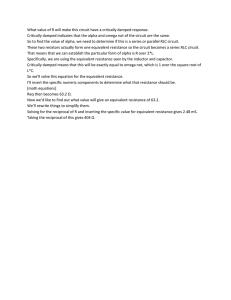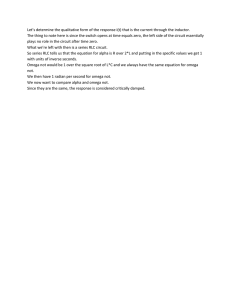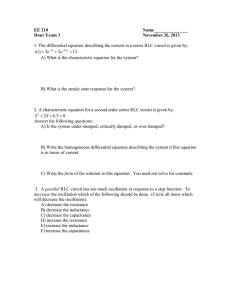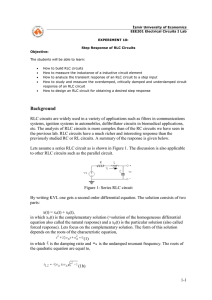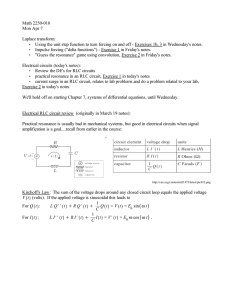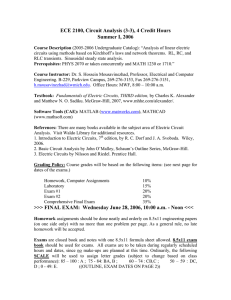Second Order Circuits I
advertisement
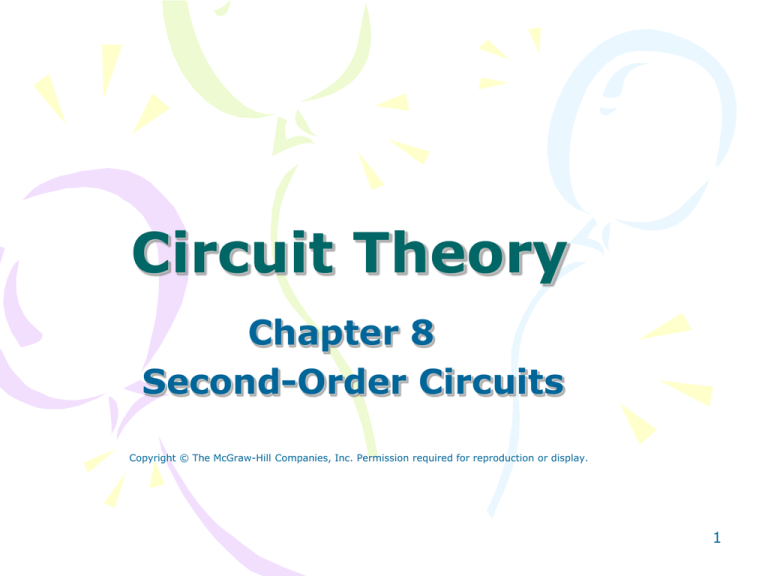
Circuit Theory
Chapter 8
Second-Order Circuits
Copyright © The McGraw-Hill Companies, Inc. Permission required for reproduction or display.
1
Second-Order Circuits
Chapter 8
8.1
8.3
8.5
8.2
8.4
Examples of 2nd order RLC circuit
The source-free parallel RLC circuit
Step response of a parallel RLC
The source-free series RLC circuit
Step response of a series RLC circuit
2
8.1 Examples of Second
Order RLC circuits (1)
What is a 2nd order circuit?
A second-order circuit is characterized by a secondorder differential equation. It consists of resistors
and the equivalent of two energy storage elements.
RLC Series
RLC Parallel
RL T-config
RC Pi-config
3
8.3 Source-Free Parallel
RLC Circuits (1)
0
Let
1
i (0) I 0 v(t )dt
L
v(0) = V0
Apply KCL to the top node:
t
v 1
dv
vdt C 0
R L
dt
Taking the derivative with
respect to t and dividing by C
The 2nd
order of
expression
d 2 v 1 dv 1
v0
2
RC dt LC
dt
4
8.3 Source-Free Parallel
RLC Circuits (2)
There are three possible solutions for the
following 2nd order differential equation:
d 2v
dv
2
02v 0
2
dt
dt
where
1
2RC
and 0
1
LC
1. If > o, over-damped case
v(t ) A1 e s1t A2 e s2t where
s1, 2 2 0
2
2. If = o, critical damped case
v(t ) ( A2 A1t ) e t
where
s1, 2
3. If < o, under-damped case
v(t ) e t ( B1 cos d t B2 sin d t ) where
d 02 2
5
8.3 Source-Free Parallel
RLC Circuits (3)
Example 3
Refer to the circuit shown below.
Find v(t) for t > 0.
• Please refer to lecture or textbook for more detail elaboration.
Answer:
v(t) = 66.67(e–10t – e–2.5t) V
6
7
8
9
8.5 Step-Response Parallel
RLC Circuits (1)
• The step response
is obtained by the
sudden application
of a dc source.
The 2nd
order of
expression
d 2i 1 di
i
Is
2
dt RC dt LC LC
It has the same form as the equation for source-free parallel
RLC circuit.
• The same coefficients (important in determining the
frequency parameters).
• Different circuit variable in the equation.
10
8.5 Step-Response Parallel
RLC Circuits (2)
The solution of the equation should have two components:
the transient response vt(t) & the steady-state response vss(t):
i(t ) it (t ) iss (t )
The transient response it is the same as that for source-free case
it (t ) A1e s1t A2 e s2t
(over-damped)
it (t ) ( A1 A2t )e t
(critical damped)
it (t ) e t ( A1 cos d t A2 sin d t )
(under-damped)
The steady-state response is the final value of i(t).
iss(t) = i(∞) = Is
The values of A1 and A2 are obtained from the initial conditions:
i(0) and di(0)/dt.
11
8.5 Step-Response Parallel
RLC Circuits (3)
Example 5
Find i(t) and v(t) for t > 0 in the circuit shown in
circuit shown below:
• Please refer to lecture or textbook for more detail elaboration.
Answer:
v(t) = Ldi/dt = 5x20sint = 100sint V
12
13
14
15
8.2 Source-Free Series
RLC Circuits (1)
• The solution of the source-free
series RLC circuit is called as the
natural response of the circuit.
• The circuit is excited by the energy
initially stored in the capacitor and
inductor.
The 2nd
order of
expression
d 2 i R di
i
0
2
L dt LC
dt
How to derive and how to solve?
16
8.2 Source-Free Series
RLC Circuits (3)
There are three possible solutions for the following
2nd order differential equation:
d 2 i R di
i
0
2
L dt LC
dt
=>
d 2i
di
2
2
0i 0
2
dt
dt
where
R
2L
and 0
1
LC
General 2nd order Form
The types of solutions for i(t) depend
on the relative values of and .
17
8.2 Source-Free Series
RLC Circuits (4)
There are three possible solutions for the following
2nd order differential equation:
d 2i
di
2
2
0i 0
2
dt
dt
1. If > o, over-damped case
i(t ) A1e s1t A2e s2t
2
where s1, 2 0
2
2. If = o, critical damped case
i(t ) ( A2 A1t )et
where
s1, 2
3. If < o, under-damped case
i (t ) e t ( B1 cos d t B2 sin d t ) where d 02 2
18
8.2 Source-Free Series
RLC Circuits (5)
Example 1
If R = 10 Ω, L = 5 H, and
C = 2 mF in 8.8, find α,
ω0, s1 and s2.
What type of natural
response will the circuit
have?
•
Please refer to lecture or textbook for more detail elaboration.
Answer: underdamped
19
20
8.2 Source-Free Series
RLC Circuits (6)
Example 2
The circuit shown below
has reached steady state
at t = 0-.
If the make-before-break
switch moves to position b
at t = 0, calculate i(t) for
t > 0.
• Please refer to lecture or textbook for more detail elaboration.
Answer: i(t) = e–2.5t[5cos1.6583t – 7.538sin1.6583t] A
21
22
23
24
8.4 Step-Response Series
RLC Circuits (1)
• The step response
is obtained by the
sudden application
of a dc source.
The 2nd
order of
expression
vs
d 2 v R dv v
2
L dt LC LC
dt
The above equation has the same form as the equation for
source-free series RLC circuit.
• The same coefficients (important in determining the
frequency parameters).
• Different circuit variable in the equation.
25
8.4 Step-Response Series
RLC Circuits (2)
The solution of the equation should have two components:
the transient response vt(t) & the steady-state response vss(t):
v(t ) vt (t ) vss (t )
The transient response vt is the same as that for source-free case
vt (t ) A1e s1t A2 e s2t
(over-damped)
vt (t ) ( A1 A2t )e t
(critically damped)
vt (t ) e t ( A1 cos d t A2 sin d t ) (under-damped)
The steady-state response is the final value of v(t).
vss(t) = v(∞)
The values of A1 and A2 are obtained from the initial conditions:
v(0) and dv(0)/dt.
26
8.4 Step-Response Series
RLC Circuits (3)
Example 4
Having been in position for a long time, the
switch in the circuit below is moved to position b
at t = 0. Find v(t) and vR(t) for t > 0.
•
Please refer to lecture or textbook for more detail elaboration.
Answer: v(t) = {10 + [(–2cos3.464t – 1.1547sin3.464t)e–2t]} V
vR(t)= [2.31sin3.464t]e–2t V
27
28
29
30
1)determine the qualitative form of the response vc(t) as
being either overdamped, underdamped, or critically damped.
Overdamped
Underdamped
Underdamped
Critically damped
2) Determine the initial value of Vr(t), and
dVr(t)/dt, and the final value of Vr(t)
http://www.rose-hulman.edu/CLEO/video/player.php?id=34&embed
Vr(0) = 6V;
dVr(0)/dt = 3V/s;
Vr(infinity) = 0V
32
3) For both the inductor current and voltage, determine their
initial values, the initial values of their derivatives, and their
final values. The capacitor has 9 J of stored energy before the
switch closes.
33
4)Plot the inductor current iL(t) and inductor voltage vL(t) for time t =
-0.1 seconds to t = 3 seconds. Confirm your results using a circuit
simulator.
34
iL(t) = 2 + 14.5 sin(4.15t) e
-1.67t
, t>=0
http://www.rose-hulman.edu/CLEO/browse/?path=1/2/76/89/224/253
35
36
